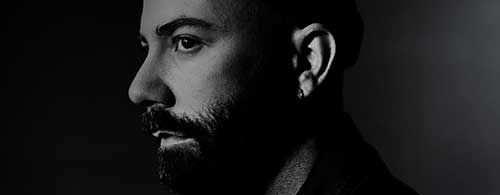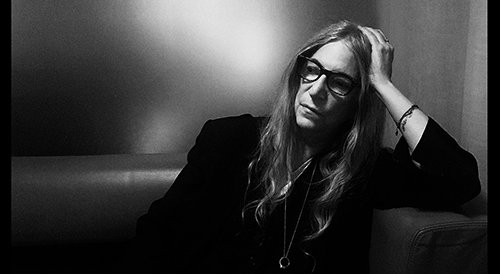![[Translate to English:] Mid-shot portrait of Rahim C. Redcar, also known as Christine and the Queens, wearing a structured black suit over a crisp white shirt. His intense, off-camera gaze and composed posture convey both theatrical presence and deep introspection. The slicked-back dark blue hair adds a bold, modern edge to his androgynous silhouette. The plain, light background enhances the minimalist elegance and draws focus to the unique identity and artistic style of the performer, blending classic formality with personal expression.](/fileadmin/user_upload/christine-and-the-queens_jasa-muller_bandeau.jpg)
Le Centre Pompidou &... Christine and the Queens
“Chris,” “Rahim Redcar,” “Christine and the Queens” — keeping up with him isn’t always straightforward. But metamorphosis is his strategy. More than that: it’s his manifesto.
Cast your mind back to 2014, when the artist, all androgynous poise and quiet defiance, burst onto the electro-pop scene under the moniker Christine and the Queens — still his stage name today. Chaleur humaine, his bilingual debut album, became a global phenomenon, selling over a million copies and establishing him as a singular force in contemporary pop.
“Chris,” “Rahim Redcar,” “Christine and the Queens” — keeping up with him isn’t always straightforward. But metamorphosis is his strategy. More than that: it’s his manifesto.
Born in Nantes in 1988, he had arrived. What followed were four increasingly uncompromising records, each more audacious than the last, plunging deep into raw, often volatile emotional terrain. The most recent, HOPECORE, was released in late 2024 — another bold step in an ever-evolving journey.
After reviving Cerrone’s iconic Supernature during the Paris Olympic Games, Christine and the Queens teams up once again with the veteran of French house for the irresistible summer 2025 hit Catching Feelings. Now poised to set the Centre Pompidou’s dancefloor alight on 25 October with a one-off performance as part of the Because Beaubourg event, we meet the artist who describes himself as “hypersensitive.”
“The Centre Pompidou is such a fundamental part of Paris. As a teenager, I used to arrange to meet people out front, or I’d go there with my mother. I'm not from Paris, and most of my cultural outings were with her. I’ve always felt that this whimsical, almost philosophical building is a work of art in itself. It's the kind of place you want to take in from a distance. I love its strange silhouette, so striking to the imagination — the colour-coded networks, the logic of its exposed pipes… It all reminds me a bit of a giant motherboard.
I love the Centre Pompidou's strange silhouette, so striking to the imagination — the colour-coded networks, the logic of its exposed pipes… It all reminds me a bit of a giant motherboard.
Christine and the Queens
I don’t go to exhibitions as often as I should — and that’s a shame — but recently I visited the Suzanne Valadon retrospective. I appreciated how the idea of the female gaze was central to the curatorial approach; it’s crucial to move away from the dominant perspective. Valadon’s gaze, in particular, is filled with immense tenderness. The exhibition was beautifully staged, with colours that were both vivid and nuanced.
I felt surprisingly at ease in that exhibition — which is rare for me, as I’m not usually fond of crowds. I had a real moment of connection with the painting Les Deux Sœurs — those two girls in heels and socks, seated on a banquette… It was strikingly feminine and unmistakably modern. It immediately reminded me of the cover of Roxy Music’s Country Life album (Bryan Ferry’s band, for the record), released in 1974.
I recently visited the Suzanne Valadon retrospective. I appreciated how the idea of the female gaze was central to the curatorial approach; it’s crucial to move away from the dominant perspective.
Christine and the Queens
One exhibition I regret missing is the one dedicated to Francis Bacon — I’m so drawn to the poetry in his work. But I was afraid I’d be too moved: Francis Bacon is something deeply personal for me — it’s between me and myself.
Among the artists I admire are Gustav Klimt, Caravaggio — for his mastery of light — and the abstraction pioneer Hilma af Klint. I’m also a devoted fan of Art Brut. I love the raw intensity of its commitment, its connection to the sacred and the spiritual. The fact that these individuals create art out of necessity, entirely outside any formal system, resonates deeply with me. Art Brut is made by people who’ve been struck by poetic lightning and have remained wholly faithful to the logic of their passion — and that moves me profoundly.” ◼
Related articles
In the calendar
Portrait of artist Rahim alias Christine and the Queens
Photo © Thomas Spault



![[Translate to English:] [Translate to English:]](/fileadmin/_processed_/e/f/csm_VALADON-soeurs-vignette_e639c60d5f.jpg)
